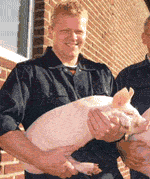Extruded feed makes piglets grow faster

The use of expanded pig feed, to which vitamins and enzymes have been added via a special technique, results in a 4% improvement in Feed conversion and a 4.4% improvement in the growth rate of piglets, according to a recent study.
 | As vacuum technology becomes increasingly sophisticated, it has become |
| One advantage of the vacuum technique is that it prevents the loss of ingredients that are essential to animal growth and which are also often very expensive. | |
As vacuum technology becomes increasingly sophisticated, it has become
possible to homogeneously, and with a very high degree of precision, inject
fats, oils, enzymes and other micro-ingredients deep into the pellet. One
advantage of the vacuum technique is that it prevents the loss of ingredients
that are essential to animal growth and which are also often very expensive. To
test whether expanded feed has an effect on the performance of piglets,
Dinnissen Process Technology performed a 6-month study on the use of piglet feed
that had been upgraded via its Pegasus® Vacuum Coater. The focus of the study
was to determine the effect of the expanded weanling feed and the vitamins and
enzymes added via the special technique using the vacuum coater.
 | Farmers noticed a striking difference. The piglets that were fed (Photo: Emile Beurskens, Saweco) |
Experimental setup
The primary challenge was to expand the feed in order to improve its
digestibility, thereby allowing the animal to utilise it more efficiently.
Another challenge was to add the vitamins and enzymes, which are essential to
the growth and health of the piglets, as accurately as possible. It is necessary
to inject the vitamins and enzymes only after the heating process is completed
to ensure that these crucial components retained their full activity. Other
important factors include the injection of the essential vitamins and enzymes
deep into the pellet and finishing the pellets with a thin protective layer to
ensure that none of the vital ingredients would be lost during transport and
within feeding installation. The study was carried out at three different farms
with a total of 500 piglets. The variables measured included feed conversion,
growth, health and uniformity of the piglets, feed consumption and consistency
of manure. The study started with weaned piglets weighing 7 – 8 kg each. The
piglets were given the new type of weanling feed every five days, after which
they were given the new expanded piglet feed for a period of three weeks. The
study also included a control group of piglets given a traditional feed
containing exactly the same ingredients as the expanded feed.
Results
During the study it was clear that the piglets ate the
improved type of feed at the same rate as the traditional feed, however, the new
feed resulted in better piglet growth. This result can be explained by a
significantly improved intake of essential nutritional ingredients from the
feed. In addition, the piglets fed with the new type of feed produced manure of
a better consistency. The uniformity of the piglets, which were similar at the
start of the study, also remained constant during the study. The pig farmers
participating in the study were enthusiastic about the results. They noticed a
striking colour difference between the different piglet groups. The piglets fed
with the new type of feed were pinker and had more hair. In addition, this group
did not have any diarrhoea problems, whereas the piglets fed with the
traditional feed did (to a limited extent). It was not necessary to provide
medicine for the piglets fed the new feed and there was also less feed waste.
The final conclusion that could be drawn from the study was that piglets fed
with the new type of feed showed a 4% improvement in feed conversion and a 4.4%
improvement in growth.
Source: Feed Mix magazine Volume 15
nr.1
Join 26,000+ subscribers
Subscribe to our newsletter to stay updated about all the need-to-know content in the feed sector, three times a week. Beheer
Beheer









 WP Admin
WP Admin  Bewerk bericht
Bewerk bericht